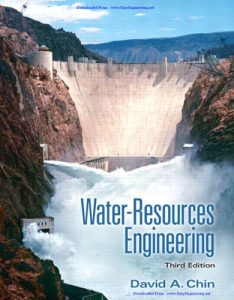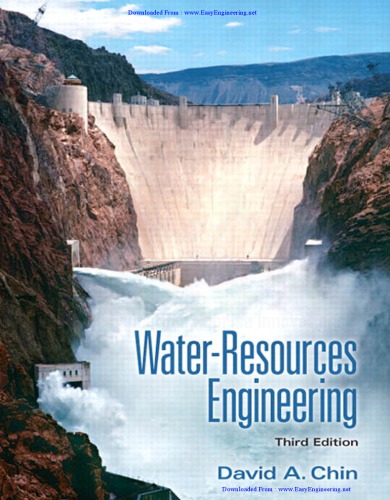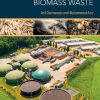Water-Resources Engineering 3rd edition – eBook PDF
$50.00 Original price was: $50.00.$35.00Current price is: $35.00.
Water-Resources Engineering – Ebook PDF
Water-Resources Engineering 3rd edition – Ebook PDF Instant Delivery – ISBN(s): 0273785923, 0273785915,9780273785927,9780273785910 
Product details:
-
ISBN-10: 0273785923, 0273785915
-
ISBN-13: 9780273785927, 9780273785910
- Author: David Chin
Water-Resources Engineering provides comprehensive coverage of hydraulics, hydrology, and water-resources planning and management. Presented from first principles, the material is rigorous, relevant to the practice of water resources engineering, and reinforced by detailed presentations of design applications. Prior knowledge of fluid mechanics and calculus (up to differential equations) is assumed.
Table of contents:
- Contents
- Preface
- 1 Introduction
- 1.1 Water-Resources Engineering
- 1.2 The Hydrologic Cycle
- 1.3 Designof Water-Resource Systems
- 1.3.1 Water-Control Systems
- 1.3.2 Water-Use Systems
- 1.3.3 Supporting Federal Agencies in the United States
- Problem
- 2 Fundamentals of Flow in Closed Conduits
- 2.1 Introduction
- 2.2 Single Pipelines
- 2.2.1 Steady-State Continuity Equation
- 2.2.2 Steady-State Momentum Equation
- 2.2.3 Steady-State Energy Equation
- 2.2.3.1 Energy and hydraulic grade lines
- 2.2.3.2 Velocity profile
- 2.2.3.3 Head losses in transitions and fittings
- 2.2.3.4 Head losses in noncircular conduits
- 2.2.3.5 Empirical friction-loss formulae
- 2.2.4 Water Hammer
- 2.3 Pipe Networks
- 2.3.1 Nodal Method
- 2.3.2 Loop Method
- 2.3.3 Application of Computer Programs
- 2.4 Pumps
- 2.4.1 AffinityLaws
- 2.4.2 Pump Selection
- 2.4.2.1 Commercially available pumps
- 2.4.2.2 System characteristics
- 2.4.2.3 Limits on pump location
- 2.4.3 Multiple-Pump Systems
- 2.4.4 Variable-Speed Pumps
- Problems
- 3 Design of Water-Distribution Systems
- 3.1 Introduction
- 3.2 Water Demand
- 3.2.1 Per-Capita Forecast Model
- 3.2.1.1 Estimation of per-capita demand
- 3.2.1.2 Estimation of population
- 3.2.2 Temporal Variations in Water Demand
- 3.2.3 Fire Demand
- 3.2.4 Design Flows
- 3.3 Components of Water-Distribution Systems
- 3.3.1 Pipelines
- 3.3.1.1 Minimumsize
- 3.3.1.2 Service lines
- 3.3.1.3 Pipe materials
- 3.3.2 Pumps
- 3.3.3 Valves
- 3.3.4 Meters
- 3.3.5 Fire Hydrants
- 3.3.6 Water-Storage Reservoirs
- 3.4 Performance Criteria for Water-Distribution Systems
- 3.4.1 Service Pressures
- 3.4.2 Allowable Velocities
- 3.4.3 Water Quality
- 3.4.4 Network Analysis
- 3.5 Building Water-Supply Systems
- 3.5.1 Specification of Design Flows
- 3.5.2 Specification of Minimum Pressures
- 3.5.3 Determination of Pipe Diameters
- Problems
- 4 Fundamentals of Flow in Open Channels
- 4.1 Introduction
- 4.2 Basic Principles
- 4.2.1 Steady-State Continuity Equation
- 4.2.2 Steady-State Momentum Equation
- 4.2.2.1 Darcy–Weisbach equation
- 4.2.2.2 Manning equation
- 4.2.2.3 Other equations
- 4.2.2.4 Velocity distribution
- 4.2.3 Steady-State Energy Equation
- 4.2.3.1 Energy grade line
- 4.2.3.2 Specific energy
- 4.3 Water-Surface Profiles
- 4.3.1 Profile Equation
- 4.3.2 Classification of Water-Surface Profiles
- 4.3.3 Hydraulic Jump
- 4.3.4 Computation of Water-Surface Profiles
- 4.3.4.1 Direct-integration method
- 4.3.4.2 Direct-step method
- 4.3.4.3 Standard-step method
- 4.3.4.4 Practical considerations
- 4.3.4.5 Profiles across bridges
- Problems
- 5 Design of Drainage Channels
- 5.1 Introduction
- 5.2 Basic Principles
- 5.2.1 Best Hydraulic Section
- 5.2.2 Boundary Shear Stress
- 5.2.3 Cohesive versus Noncohesive Materials
- 5.2.4 Bends
- 5.2.5 Channel Slopes
- 5.2.6 Freeboard
- 5.3 Design of Channels with Rigid Linings
- 5.4 Design of Channels with Flexible Linings
- 5.4.1 General Design Procedure
- 5.4.2 Vegetative Linings and Bare Soil
- 5.4.3 RECP Linings
- 5.4.4 Riprap, Cobble, and Gravel Linings
- 5.4.5 Gabions
- 5.5 CompositeLinings
- Problems
- 6 Design of Sanitary Sewers
- 6.1 Introduction
- 6.2 Quantity of Wastewater
- 6.2.1 Residential Sources
- 6.2.2 Nonresidential Sources
- 6.2.3 Inflow and Infiltration (I/I)
- 6.2.4 Peaking Factors
- 6.3 Hydraulics of Sewers
- 6.3.1 Manning Equation with Constant n
- 6.3.2 Manning Equation with Variable n
- 6.3.3 Self-Cleansing
- 6.3.4 Scour Prevention
- 6.3.5 Design Computations for Diameter and Slope
- 6.3.6 Hydraulics of Manholes
- 6.4 System Design Criteria
- 6.4.1 System Layout
- 6.4.2 Pipe Material
- 6.4.3 Depth of Sanitary Sewer
- 6.4.4 Diameter and Slope of Pipes
- 6.4.5 Hydraulic Criteria
- 6.4.6 Manholes
- 6.4.7 Pump Stations
- 6.4.8 Force Mains
- 6.4.9 Hydrogen-Sulfide Control
- 6.4.10 Combined Sewers
- 6.5 Design Computations
- 6.5.1 Design Aids
- 6.5.1.1 Manning’s n
- 6.5.1.2 Minimum slope for self-cleansing
- 6.5.2 Procedure for System Design
- Problems
- 7 Design of Hydraulic Structures
- 7.1 Introduction
- 7.2 Culverts
- 7.2.1 Hydraulics
- 7.2.1.1 Submerged entrances
- 7.2.1.2 Unsubmerged entrances
- 7.2.2 Design Constraints
- 7.2.3 Sizing Calculations
- 7.2.3.1 Fixed-headwater method
- 7.2.3.2 Fixed-flow method
- 7.2.3.3 Minimum-performance method
- 7.2.4 Roadway Overtopping
- 7.2.5 Riprap/Outlet Protection
- 7.3 Gates
- 7.3.1 Free Discharge
- 7.3.2 Submerged Discharge
- 7.3.3 Empirical Equations
- 7.4 Weirs
- 7.4.1 Sharp-Crested Weirs
- 7.4.1.1 Rectangular weirs
- 7.4.1.2 V-notchweirs
- 7.4.1.3 Compound weirs
- 7.4.1.4 Other types of sharp-crested weirs
- 7.4.2 Broad-Crested Weirs
- 7.4.2.1 Rectangular weirs
- 7.4.2.2 Compound weirs
- 7.4.2.3 Gabionweirs
- 7.5 Spillways
- 7.5.1 Uncontrolled Spillways
- 7.5.2 Controlled (Gated) Spillways
- 7.5.2.1 Gates seated on the spillway crest
- 7.5.2.2 Gates seated downstream of the spillway crest
- 7.6 Stilling Basins
- 7.6.1 Type Selection
- 7.6.2 Design Procedure
- 7.7 Dams and Reservoirs
- 7.7.1 Types of Dams
- 7.7.2 Reservoir Storage
- 7.7.2.1 Sediment accumulation
- 7.7.2.2 Determination of storage requirements
- 7.7.3 Hydropower
- 7.7.3.1 Turbines
- 7.7.3.2 Turbine performance
- 7.7.3.3 Feasibility of hydropower
- Problems
- 8 Probability and Statistics in Water-Resources Engineering
- 8.1 Introduction
- 8.2 Probability Distributions
- 8.2.1 Discrete Probability Distributions
- 8.2.2 Continuous Probability Distributions
- 8.2.3 Mathematical Expectation and Moments
- 8.2.4 Return Period
- 8.2.5 Common Probability Functions
- 8.2.5.1 Binomial distribution
- 8.2.5.2 Geometric distribution
- 8.2.5.3 Poisson distribution
- 8.2.5.4 Exponential distribution
- 8.2.5.5 Gamma/Pearson Type III distribution
- 8.2.5.6 Normal distribution
- 8.2.5.7 Log-normal distribution
- 8.2.5.8 Uniform distribution
- 8.2.5.9 Extreme-value distributions
- 8.2.5.10 Chi-square distribution
- 8.3 Analysis of Hydrologic Data
- 8.3.1 Estimation of Population Distribution
- 8.3.1.1 Probability distribution of observed data
- 8.3.1.2 Hypothesis tests
- 8.3.1.3 Model selection criteria
- 8.3.2 Estimation of Population Parameters
- 8.3.2.1 Method of moments
- 8.3.2.2 Maximum-likelihood method
- 8.3.2.3 Method of L-moments
- 8.3.3 Frequency Analysis
- 8.3.3.1 Normal distribution
- 8.3.3.2 Log-normal distribution
- 8.3.3.3 Gamma/Pearson Type III distribution
- 8.3.3.4 Log-Pearson Type III distribution
- 8.3.3.5 Extreme-value Type I distribution
- 8.3.3.6 General extreme-value (GEV) distribution
- 8.4 Uncertainty Analysis
- Problems
- 9 Fundamentals of Surface-Water Hydrology I: Rainfall and Abstractions
- 9.1 Introduction
- 9.2 Rainfall
- 9.2.1 Measurement of Rainfall
- 9.2.2 Statistics of Rainfall Data
- 9.2.2.1 Rainfall statistics in the United States
- 9.2.2.2 Secondary estimation of IDF curves
- 9.2.3 Spatial Averaging and Interpolation of Rainfall
- 9.2.4 Design Rainfall
- 9.2.4.1 Return period
- 9.2.4.2 Rainfall duration
- 9.2.4.3 Rainfall depth
- 9.2.4.4 Temporal distribution
- 9.2.4.5 Spatial distribution
- 9.2.5 Extreme Rainfall
- 9.2.5.1 Rational estimation method
- 9.2.5.2 Statistical estimation method
- 9.2.5.3 World-record precipitation amounts
- 9.2.5.4 Probable maximum storm
- 9.3 Rainfall Abstractions
- 9.3.1 Interception
- 9.3.2 Depression Storage
- 9.3.3 Infiltration
- 9.3.3.1 The infiltration process
- 9.3.3.2 Horton model
- 9.3.3.3 Green–Ampt model
- 9.3.3.4 NRCS curve-number model
- 9.3.3.5 Comparison of infiltration models
- 9.3.4 Rainfall Excess on Composite Areas
- 9.4 Baseflow
- Problems
- 10 Fundamentals of Surface-Water Hydrology II: Runoff
- 10.1 Introduction
- 10.2 Mechanisms of Surface Runoff
- 10.3 Time of Concentration
- 10.3.1 Overland Flow
- 10.3.1.1 Kinematic-wave equation
- 10.3.1.2 NRCS method
- 10.3.1.3 Kirpich equation
- 10.3.1.4 Izzard equation
- 10.3.1.5 Kerby equation
- 10.3.2 Channel Flow
- 10.3.3 Accuracy of Estimates
- 10.4 Peak-Runoff Models
- 10.4.1 The Rational Method
- 10.4.2 NRCS-TR55 Method
- 10.5 Continuous-Runoff Models
- 10.5.1 Unit-Hydrograph Theory
- 10.5.2 Instantaneous Unit Hydrograph
- 10.5.3 Unit-Hydrograph Models
- 10.5.3.1 Snyder unit-hydrograph model
- 10.5.3.2 NRCS dimensionless unit hydrograph
- 10.5.3.3 Accuracy of unit-hydrograph models
- 10.5.4 Time-Area Models
- 10.5.5 Kinematic-Wave Model
- 10.5.6 Nonlinear-Reservoir Model
- 10.5.7 Santa Barbara Urban Hydrograph Model
- 10.5.8 Extreme Runoff Events
- 10.6 Routing Models
- 10.6.1 Hydrologic Routing
- 10.6.1.1 Modified Puls method
- 10.6.1.2 Muskingum method
- 10.6.2 Hydraulic Routing
- 10.7 Water-Quality Models
- 10.7.1 Event-Mean Concentrations
- 10.7.2 Regression Equations
- 10.7.2.1 USGS model
- 10.7.2.2 EPA model
- Problems
- 11 Design of Stormwater-Collection Systems
- 11.1 Introduction
- 11.2 Street Gutters
- 11.3 Inlets
- 11.3.1 CurbInlets
- 11.3.2 Grate Inlets
- 11.3.3 Combination Inlets
- 11.3.4 Slotted Inlets
- 11.4 Roadside and Median Channels
- 11.5 Storm Sewers
- 11.5.1 Calculation of Design Flow Rates
- 11.5.2 Pipe Sizing and Selection
- 11.5.3 Manholes
- 11.5.4 Determination of Impervious Area
- 11.5.5 System-Design Computations
- 11.5.6 Other Design Considerations
- Problems
- 12 Design of Stormwater-Management Systems
- 12.1 Introduction
- 12.2 Performance Goals
- 12.2.1 Quantity Control
- 12.2.2 Quality Control
- 12.3 Design of Stormwater Control Measures
- 12.3.1 Storage Impoundments
- 12.3.1.1 Detentionbasins—Designparameters
- 12.3.1.2 Wet detention basins
- 12.3.1.3 Dry detention basins
- 12.3.1.4 Design of outlet structures
- 12.3.1.5 Design for flood control
- 12.3.2 Infiltration Basins
- 12.3.3 Swales
- 12.3.3.1 Retention swales
- 12.3.3.2 Biofiltration swales
- 12.3.4 Vegetated Filter Strips
- 12.3.5 Bioretention Systems
- 12.3.6 Exfiltration Trenches
- 12.3.6.1 General design guidelines
- 12.3.6.2 Design for flood control
- 12.3.6.3 Design for water-quality control
- 12.3.7 Subsurface Exfiltration Galleries
- 12.4 Selection of SCMs for Water-Quality Control
- 12.4.1 Nonstructural SCMs
- 12.4.2 Structural SCMs
- 12.4.3 Other Considerations
- 12.5 Major Drainage System
- Problems
- 13 Estimation of Evapotranspiration
- 13.1 Introduction
- 13.2 Penman–Monteith Equation
- 13.2.1 Aerodynamic Resistance
- 13.2.2 Surface Resistance
- 13.2.3 Net Radiation
- 13.2.3.1 Shortwave radiation
- 13.2.3.2 Longwave radiation
- 13.2.4 Soil Heat Flux
- 13.2.5 Latent Heat of Vaporization
- 13.2.6 Psychrometric Constant
- 13.2.7 Saturation Vapor Pressure
- 13.2.8 Vapor-Pressure Gradient
- 13.2.9 Actual Vapor Pressure
- 13.2.10 Air Density
- 13.3 Application of the PM Equation
- 13.4 Potential Evapotranspiration
- 13.5 Reference Evapotranspiration
- 13.5.1 FAO56-Penman–Monteith Method
- 13.5.2 ASCE Penman–Monteith Method
- 13.5.3 Evaporation Pans
- 13.5.4 Empirical Methods
- 13.6 Actual Evapotranspiration
- 13.6.1 Index-of-Dryness Method
- 13.6.2 Crop-Coefficient Method
- 13.6.3 Remote Sensing
- 13.7 Selection of ETE stimation Method
- Problems
- 14 Fundamentals of Groundwater Hydrology I: Governing Equations
- 14.1 Introduction
- 14.2 Darcy’s Law
- 14.2.1 Hydraulic Conductivity
- 14.2.1.1 Empirical formulae
- 14.2.1.2 Classification
- 14.2.1.3 Anisotropic properties
- 14.2.1.4 Stochastic properties
- 14.3 General Flow Equation
- 14.4 Two-Dimensional Approximations
- 14.4.1 Unconfined Aquifers
- 14.4.2 Confined Aquifers
- 14.5 Flow in the Unsaturated Zone
- Problems
- 15 Fundamentals of Groundwater Hydrology II: Applications
- 15.1 Introduction
- 15.2 Steady-State Solutions
- 15.2.1 Unconfined Flow Between Two Reservoirs
- 15.2.2 Well in a Confined Aquifer
- 15.2.3 Well in an Unconfined Aquifer
- 15.2.4 Well in a Leaky Confined Aquifer
- 15.2.5 Well in an Unconfined Aquifer with Recharge
- 15.2.6 Partially Penetrating Wells
- 15.3 Unsteady-State Solutions
- 15.3.1 Well in a Confined Aquifer
- 15.3.2 Well in an Unconfined Aquifer
- 15.3.3 Well in a Leaky Confined Aquifer
- 15.3.4 Other Solutions
- 15.4 Principle of Superposition
- 15.4.1 Multiple Wells
- 15.4.2 Well in Uniform Flow
- 15.5 Method of Images
- 15.5.1 Constant-Head Boundary
- 15.5.2 Impermeable Boundary
- 15.5.3 Other Applications
- 15.6 Saltwater Intrusion
- Problems
- 16 Design of Groundwater Systems
- 16.1 Introduction
- 16.2 Design of Wellfields
- 16.3 Wellhead Protection
- 16.3.1 Delineation of Wellhead Protection Areas
- 16.3.2 Time-of-Travel Approach
- 16.4 Design and Construction of Water-Supply Wells
- 16.4.1 Types of Wells
- 16.4.2 Design of Well Components
- 16.4.2.1 Casing
- 16.4.2.2 Screenintake
- 16.4.2.3 Gravel pack
- 16.4.2.4 Pump
- 16.4.2.5 Other considerations
- 16.4.3 Performance Assessment
- 16.4.4 Well Drilling
- 16.5 Design of Aquifer Pumping Tests
- 16.5.1 Pumping Well
- 16.5.2 Observation Wells
- 16.5.3 Field Procedures
- 16.6 Design of Slug Tests
- 16.7 Design of Exfiltration Trenches
- 16.8 Seepage Meters
- Problems
- 17 Water-Resources Planning
- 17.1 Introduction
- 17.2 Planning Process
- 17.3 Economic Feasibility
- 17.3.1 Compound-Interest Factors
- 17.3.1.1 Single-payment factors
- 17.3.1.2 Uniform-series factors
- 17.3.1.3 Arithmetic-gradient factors
- 17.3.1.4 Geometric-gradient factors
- 17.3.2 Evaluating Alternatives
- 17.3.2.1 Present-worth analysis
- 17.3.2.2 Annual-worth analysis
- 17.3.2.3 Rate-of-return analysis
- 17.3.2.4 Benefit–cost analysis
- Problems
- A: Units and Conversion Factors
- A.1 Units
- A.2 Conversion Factors
- B: Fluid Properties
- B.1 Water
- B.2 Organic Compounds Found in Water
- B.3 Air at Standard Atmospheric Pressure
- C: Statistical Tables
- C.1 Areas Under Standard Normal Curve
- C.2 Frequency Factors for Pearson Type III Distribution
- C.3 Critical Values of the Chi-Square Distribution
- C.4 Critical Values for the Kolmogorov–Smirnov Test Statistic
- D: Special Functions
- D.1 Error Function
- D.2 Bessel Functions
- D.2.1 Definition
- D.2.2 Evaluation of Bessel Functions
- D.2.2.1 Bessel function of the first kind of order n
- D.2.2.2 Bessel function of the second kind of order n
- D.2.2.3 Modified Bessel function of the first kind of order n
- D.2.2.4 Modified Bessel function of the second kind of order n
- D.2.2.5 Tabulated values of useful Bessel functions
- D.3 Gamma Function
- D.4 Exponential Integral
- E: Pipe Specifications
- E.1 PVCPipe
- E.2 Ductile-Iron Pipe
- E.3 Concrete Pipe
- E.4 Physical Properties of Common Pipe Materials
- F: Unified Soil Classification System
- F.1 Definition of Soil Groups
- F.2 Terminology
People also search:
hydrology and water resources engineering
hydraulic and water resources engineering
environmental and water resources engineering
is water resources engineering a good career
masters in water resources engineering


